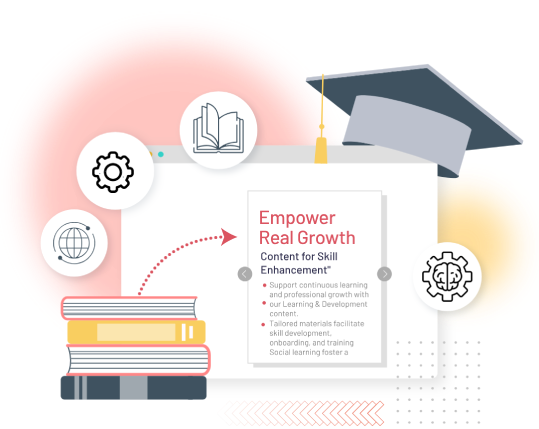
Incorporating corporate eLearning strategies into your organization’s learning and development (L&D) processes can be helpful. Organizations increasingly require effective eLearning content development solutions to meet technological advancements and business demands. As companies strive to enhance employee performance, the importance of innovative learning strategies cannot be overstated.
In this blog, we will explore the latest key trends in learning content development that can help businesses train their teams more effectively. These trends include interactive eLearning modules, visual content for eLearning, AI in eLearning, and data-driven learning analytics. By understanding these five trends, organizations can improve their overall training outcomes.

Knowing about eLearning is essential for aspiring content developers. This format allows learners to progress at their own pace. It helps them retain complex concepts through engaging multimedia elements like videos and interactive modules.
Well-structured eLearning courses provide clear objectives that align with essential skills in content development. Collaborative tools foster networking and enrich the learning experience. Immediate feedback mechanisms help learners refine their skills, ensuring they are prepared for industry demands.
Opting for eLearning approaches can offer access to resources, including case studies and best practices. This information empowers learners to stay current in a rapidly evolving environment. Embracing eLearning is crucial for anyone seeking proficiency in content development.
Let’s look at the trends in learning content development.
Interactive eLearning modules are becoming increasingly popular as they engage learners more effectively than traditional methods. These modules incorporate elements that require active participation from learners, making the educational experience dynamic and enjoyable.
Interactive learning is crucial for fostering engagement and retaining information. Learners actively participating in their education are more likely to absorb and apply knowledge effectively. This approach transforms passive learning into an engaging experience that motivates employees to take charge of their development. For example, 74% of teachers use digital game-based learning to enhance lessons, demonstrating the growing reliance on interactive content in education.
Organizations implementing interactive eLearning modules can expect higher employee satisfaction and performance levels. Interactive modules significantly improve learning outcomes by actively involving learners and promoting hands-on activities.

Source: freepik
Visual content has become an essential component of effective eLearning strategies. By incorporating images, videos, infographics, and animations into training materials, organizations can enhance comprehension and retention among learners.
Visual content plays a vital role in how information is processed and remembered. People are more likely to retain information when it is presented visually rather than through text alone. According to John Medina, 65% of people remember information presented with visuals. This makes visual elements powerful for improving understanding and engagement during training sessions.
By leveraging visual content in their eLearning strategies, businesses can foster a more engaging training environment that enhances employee performance. Visual content can make learning experiences more engaging and memorable for learners.

Source: freepik
Artificial Intelligence helped in the development of eLearning by personalizing content delivery and optimizing individual learning paths for employees. Integrating AI technologies enables organizations to create tailored training experiences based on specific learner needs. According to Market.us, 47% of the LMS models will be powered by AI by the end of 2024.
AI's ability to critically analyze vast amounts of data allows organizations to understand their workforce better than ever before. This insight enables targeted training initiatives that address skill gaps within diverse teams while enhancing overall effectiveness.
By embracing AI in eLearning strategies, businesses can create more effective training programs that adapt to the evolving needs of their workforce. It can also maximize resource efficiency. AI-driven analytics can enhance the personalization of learning experiences.

Source: freepik
Microlearning is considered as a powerful trend in eLearning content development. This approach breaks down extremely complex topics into bite-sized, easily digestible chunks of information, which learners can quickly consume and absorb.
Microlearning caters to the modern learner's short attention span and busy schedule. It allows employees to engage in brief, focused learning sessions that fit seamlessly into their workdays. This approach ensures continuous learning without overwhelming employees with lengthy training sessions.
Businesses can provide just-in-time training that addresses specific skills or knowledge gaps. Incorporating microlearning into their eLearning strategies supports continuous learning and helps employees apply new knowledge immediately in their work.

Source: freepik
Data-driven learning is becoming increasingly important. Organizations seek ways to measure learning outcomes effectively through analytics tools integrated into their training programs. According to Vorecol, using data analytics to improve training increases employee engagement by 60%.
Utilizing data analytics allows businesses to track learner progress and identify knowledge gaps within their teams. This enables informed decisions regarding future training initiatives, which are based on empirical evidence rather than assumptions alone.
Embracing data-driven approaches ensures organizations remain agile. They can adapt their corporate training strategies as needed while maximizing the impact on learner performance outcomes overall.
Effective content is crucial for business success. Content agencies in India provide expertise to help organizations engage their audience. By leveraging their services, companies can enhance marketing strategies and improve brand storytelling.
At LexiConn, our commitment to enhancing client visibility through quality content has led to significant success stories. One such case involved a leading technology company facing challenges in effectively communicating its value propositions through blogs.
Our team analyzed Amazon's existing blog strategy. We identified gaps in audience engagement and content relevance, which hindered lead generation.
Read: How LexiConn Helped Amazon Increase Web Traffic with SEO BlogsTo address these issues, LexiConn developed a tailored content strategy focusing on SEO-driven business blogs. We emphasized informative, engaging topics aligned with the client's industry trends.
Leveraging our skilled writers, we produced well-researched, high-quality blogs that highlighted the client's expertise. Each blog was crafted with a focus on clarity, readability, and actionable insights.
The results were remarkable. Within months, the client experienced a significant increase in web traffic and lead generation. Our strategic focus on relevant keywords and engaging formats improved their search engine rankings, enhancing visibility.
LexiConn's collaboration didn't end with content creation. We provided ongoing support, analyzing performance metrics to refine strategies continually. This adaptability ensured sustained growth and engagement.
LexiConn's expertise in creating effective business blogs demonstrates the power of a strategic content approach. By partnering with us, businesses can enhance their online presence and drive tangible results. Efficient content development techniques are the key to success.
As businesses face the evolving landscape of eLearning, staying ahead of trends is crucial. Organizations can revolutionize training through effective corporate eLearning strategies. These strategies incorporate interactive modules, visual content, AI, mobile learning, and data-driven analytics.
Ready to elevate your eLearning content and boost employee performance? Our core team of experts can help you implement these cutting-edge corporate eLearning strategies. Visit us at Lexiconn or drop us a line at [email protected]. LexiConn also offers a free 30-minute content consultation session to help you with your content strategy.



I have read and accept the Privacy Policy
Read More